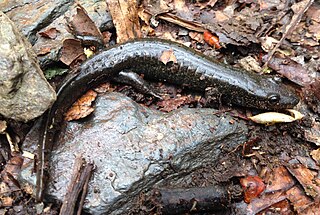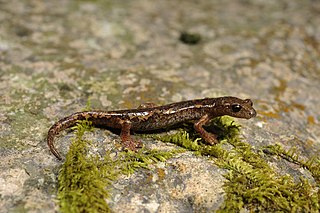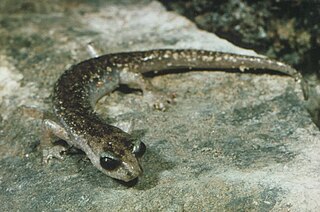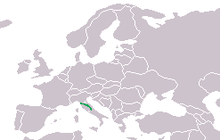
The gold-striped salamander or golden-striped salamander is a species of salamander in the family Salamandridae. It is the only species of the genus Chioglossa. It is found in the north-west of Iberia at an altitude of up to 1,300 m. It is threatened by habitat loss.
Lyciasalamandra flavimembris, the Marmaris Lycian salamander or Marmaris salamander, is a species of salamander in the family Salamandridae. It is endemic to Turkey and is found along the southwestern Anatolian coast between Marmaris and Ula. It was first described as subspecies of Mertensiella luschani, now Lyciasalamandra luschani.

The Persian brook salamander or Persian mountain salamander is an endemic amphibian species of salamander in the family Hynobiidae found in Iran and possibly Azerbaijan.

The blackbelly salamander is a species of salamander in the family Plethodontidae. It is endemic to the United States. Its natural habitats are rivers, intermittent rivers, and freshwater springs. It is threatened by habitat loss.

The limestone salamander is a member of the lungless salamander family. Discovered in 1952, this species belongs to a genus endemic to California. It is endemic to a portion of the Merced River Canyon in Mariposa County, California.
The Shasta salamander is a species of salamander in the family Plethodontidae. It is endemic to Shasta County in California.
Ixalotriton niger, the black jumping salamander, is a species of salamander in the family Plethodontidae. It is endemic to Mexico. Its natural habitats are subtropical or tropical moist montane forests and rocky areas and it is threatened by habitat loss.

Dunn's salamander is a species of salamander in the family Plethodontidae endemic to the western United States.

The Pigeon Mountain salamander is a species of salamander in the family Plethodontidae. It is endemic to Pigeon Mountain in the US state of Georgia.

Weller's salamander is a species of salamander in the family Plethodontidae. This species in endemic to the southeastern mountain range of the United States. It is mainly found in North Carolina near Grandfather Mountain. The salamanders have a unique metallic spotting which distinguishes them from other Plethodon species and other salamanders in the area. They mainly inhabit cool forests with rocky areas.

The Yonahlossee salamander is a particularly large woodland salamander from the southern Appalachian Mountains in the United States. The species is a member of the family Plethodontidae, which is characterized by being lungless and reproductive direct development. P. yonahlossee was first described in 1917 by E.R Dunn on a collection site on Grandfather Mountain in North Carolina. The common and specific name is of Native American origin, meaning “trail of the bear”. It is derived from Yonahlossee Road northeast of Linville, where the specimen was first described.

Ambrosi's cave salamander or the Spezia cave salamander is a species of salamander in the family Plethodontidae. Endemic to northwestern Italy, its natural habitats are temperate forests, rocky areas, caves, and subterranean habitats. It is threatened by habitat loss.

The Monte Albo cave salamander or Stefani's salamander is a species of salamander in the family Plethodontidae, endemic to Sardinia.

The brown cave salamander, also known as Gene's cave salamander, Sardinian cave salamander, or simply Sardinian salamander, is a species of salamander in the family Plethodontidae. It is endemic to Sardinia (Italy). Its natural habitats are temperate forests, rocky areas, caves, and subterranean habitats. It is threatened by habitat loss.

The imperial cave salamander, imperial salamander, odorous cave salamander, or scented cave salamander is a species of salamander in the family Plethodontidae. It is endemic to Sardinia.
Platymantis spelaeus, also known as the Negros cave frog or cave wrinkled ground frog, is a species of frog in the family Ceratobatrachidae. It is endemic to the Philippines, where it is only found in the forested limestone areas of southern Negros. It is one of the two cave-dwelling Platymantis species, the other one being Platymantis insulatus.

Platymantis biak, also known as the Luzon limestone forest frog, is a species of frog in the family Ceratobatrachidae. It is endemic to the island of Luzon, the Philippines, where it is known from the Biak-na-Bato National Park, its type locality, and from the immediate vicinity of the park. The specific name biak is Tagalog meaning "crevice" or "crack" and refers to the preferred limestone karst habitat at the type locality.

Speleomantes strinatii, the French cave salamander, North-west Italian cave salamander, or Strinati's cave salamander is a small species of salamander found in northwest Italy and southeast France. It is very similar in appearance to the Italian cave salamander, but has a paler belly.
















